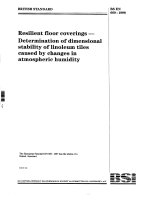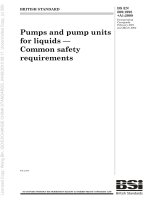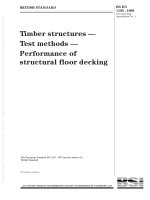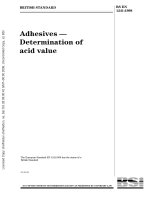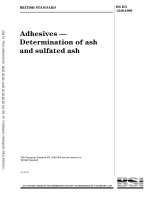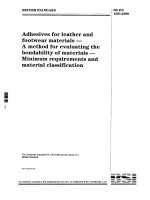Bsi bs en 01770 1998
Bạn đang xem bản rút gọn của tài liệu. Xem và tải ngay bản đầy đủ của tài liệu tại đây (161.9 KB, 14 trang )
BRITISH STANDARD
Products and systems for the
protection and repair of
concrete structures Ð Test
methods Ð Determination of
the coefficient of thermal
expansion
The European Standard EN 1770:1998 has the status of a
British Standard
ICS 91.080.40
NO COPYING WITHOUT BSI PERMISSION EXCEPT AS PERMITTED BY COPYRIGHT LAW
|
|
|
|
|
|
|
|
|
|
|
|
|
|
|
|
|
|
|
|
|
|
|
|
|
|
|
|
|
|
|
|
|
|
|
|
|
|
|
|
|
|
|
|
|
|
|
|
|
|
|
|
|
|
|
|
|
|
|
|
|
|
|
|
|
|
|
|
|
|
|
|
|
|
|
|
|
|
|
|
|
|
|
|
|
|
|
|
|
|
|
|
|
|
|
|
|
|
|
|
|
|
|
|
|
|
|
|
|
|
|
|
|
|
|
|
|
|
|
|
|
|
|
|
|
|
|
|
|
BS EN
1770:1998
BS EN 1770:1998
National foreword
This British Standard is the English language version of EN 1770:1998.
The UK participation in its preparation was entrusted by Technical Committee
B/517, Concrete, to Subcommittee B/517/8, Protection and repair of concrete
structures, which has the responsibility to:
Ð aid enquirers to understand the text;
Ð present to the responsible European committee any enquiries on the
interpretation, or proposals for change, and keep the UK interests informed;
Ð monitor related international and European developments and promulgate
them in the UK.
A list of organizations represented on this committee can be obtained on request to
its secretary.
Cross-references
The British Standards which implement international or European publications
referred to in this document may be found in the BSI Standards Catalogue under the
section entitled ªInternational Standards Correspondence Indexº, or by using the
ªFindº facility of the BSI Standards Electronic Catalogue.
A British Standard does not purport to include all the necessary provisions of a
contract. Users of British Standards are responsible for their correct application.
Compliance with a British Standard does not of itself confer immunity
from legal obligations.
Summary of pages
This document comprises a front cover, an inside front cover, the EN title page,
pages 2 to 10, an inside back cover and a back cover.
This British Standard, having
been prepared under the
direction of the Sector
Committee for Building and Civil
Engineering, was published under
the authority of the Standards
Committee and comes into effect
on 15 November 1998
BSI 1998
ISBN 0 580 30117 6
Amendments issued since publication
Amd. No.
Date
Text affected
EN 1770
EUROPEAN STANDARD
NORME EUROPÊENNE
EUROPẰISCHE NORM
March 1998
ICS 91.080.40
Descriptors: concrete structures, repairs, protection, materials, binders: materials, products for concrete construction, tests,
determination, thermal expansion
English version
Products and systems for the protection and repair of concrete
structures Ð Test methods Ð Determination of the coefficient of
thermal expansion
Produits et systeÁmes pour la protection et la
reÂparation des structures en beÂton Ð MeÂthodes
d'essais Ð DeÂtermination du coefficient de
dilatation thermique
Produkte und Systeme fuÈr den Schutz und die
Instandsetzung von Betontragwerken Ð
PruÈfverfahren Ð Bestimmung des
WaÈrmeausdehnungskoeffizienten
This European Standard was approved by CEN on 22 February 1998.
CEN members are bound to comply with the CEN/CENELEC Internal Regulations
which stipulate the conditions for giving this European Standard the status of a
national standard without any alteration. Up-to-date lists and bibliographical
references concerning such national standards may be obtained on application to
the Central Secretariat or to any CEN member.
This European Standard exists in three official versions (English, French, German).
A version in any other language made by translation under the responsibility of a
CEN member into its own language and notified to the Central Secretariat has the
same status as the official versions.
CEN members are the national standards bodies of Austria, Belgium, Czech
Republic, Denmark, Finland, France, Germany, Greece, Iceland, Ireland, Italy,
Luxembourg, Netherlands, Norway, Portugal, Spain, Sweden, Switzerland and
United Kingdom.
CEN
European Committee for Standardization
Comite EuropeÂen de Normalisation
EuropaÈisches Komitee fuÈr Normung
Central Secretariat: rue de Stassart 36, B-1050 Brussels
1998 CEN All rights of exploitation in any form and by any means reserved worldwide for CEN national
Members.
Ref. No. EN 1770:1998 E
Page 2
EN 1770:1998
Foreword
This European Standard has been prepared by
Technical Committee CEN/TC 104, Concrete
(performance, production, placing and compliance
criteria), the Secretariat of which is held by DIN.
NOTE This European Standard should be read together with
EN 1504-1.
This European Standard shall be given the status of a
national standard, either by publication of an identical
text or by endorsement, at the latest by
September 1998, and conflicting national standards
shall be withdrawn at the latest by September 1998.
According to the CEN/CENELEC Internal Regulations,
the national standards organizations of the following
countries are bound to implement this European
Standard: Austria, Belgium, Czech Republic, Denmark,
Finland, France, Germany, Greece, Iceland, Ireland,
Italy, Luxembourg, Netherlands, Norway, Portugal,
Spain, Sweden, Switzerland and the United Kingdom.
Contents
Foreword
1
Scope
2
Normative references
3
Thermomechanical analysis
3.1 Principle
3.2 Apparatus
3.3 Test procedure
3.4 Calculation
3.5 Test report
4
Alternative method
4.1 Principle
4.2 Apparatus
4.3 Test procedure
4.4 Calculation of the coefficient of
thermal expansion
4.5 Test report
5
Reproducibility
Annex A (informative) Bibliography
Page
2
3
3
3
3
3
3
4
4
4
4
5
5
6
6
6
10
BSI 1998
Page 3
EN 1770:1998
1 Scope
This European Standard specifies methods for the
determination of the coefficient of thermal expansion
of hardened structural bonding agents. The first
method provides a continuous measurement of linear
thermal expansion using thermomechanical analysis
techniques. This method may also be used for surface
protection systems. The alternative method uses prisms
of 40 mm 3 40 mm 3 160 mm. This method may also
be used for repair mortar. Both methods are suitable
for bonding agents formulated with fillers of up
to 4 mm.
2 Normative references
This European Standard incorporates by dated or
undated reference, provisions from other publications.
These normative references are cited at the
appropriate places in the text and the publications are
listed hereafter. For dated references, subsequent
amendments to or revisions of any of these
publications apply to this European Standard only
when incorporated in it by amendment or revision.
For undated references the latest edition of the
publication referred to applies.
prEN 12190, Products and systems for the protection
and repair of concrete structures Ð Test methods Ð
Determination of compressive strength.
3 Thermomechanical analysis
3.1 Principle
The coefficient of thermal expansion of resinous
materials is to be measured at an age of 7 days
(storage at (21 ± 2) 8C and (60 ± 10) % relative
humidity).
Once hardened the bonding agent is subjected to a
constant heating rate. This method uses a
thermomechanical analyser to determine the changes
in length, which is electronically recorded as a
function of temperature. The coefficient of linear
thermal expansion can be calculated from the recorded
data.
3.2 Apparatus
3.2.1 Thermomechanical analyser, or similar device,
consisting of:
a) specimen holder and probe, (constructed from
low-expansion materials such as fused quartz) that
transmits changes in the length of the specimen to
the transducer. The shape and size of the probe shall
be such that the load applied shall not cause
indentation of the specimen, during testing;
b) transducer, for sensing movement of the probe
resulting from changes in length of the specimen and
for translating these movements into an electrical
signal suitable for input to a recording system;
c) temperature sensing element, for measuring the
temperature of the test specimen;
BSI 1998
d) a recording system to record the changes in
specimen length as a function of specimen
temperature. The combination of transducer and
recorder shall have sufficient sensitivity to produce a
minimum of 1 mm of chart deflection per 100 nm of
probe movement with provision for less sensitive
ranges, where needed.
3.2.2 Furnace, for uniformly heating the specimen
(preferably at 2 8C/min), at a predetermined rate over
the testing temperature range with provision for
cooling the specimen when sub-ambient temperature
measurements are to be made.
3.2.3 Means of purging the specimen environment
with a dry inert gas such as nitrogen or helium (for
temperatures > 100 8C).
3.2.4 Callipers, capable of measuring linear
dimensions to an accuracy of not less than 25 mm.
3.3 Test procedure
3.3.1 Sampling material
The bonding agent to be tested shall be taken from
one production batch. The specimen may be cut from
a prism 40 mm 3 40 mm 3 160 mm, as used for other
tests.
3.3.2 Test specimens
Cylindrical or square shaped specimens shall be
between 25 mm and 50 mm in length and have ends flat
and parallel to within ±25 mm. Lateral dimensions shall
not exceed 10 mm. Other lengths may be used
provided that they are noted in the report.
The specimens shall be measured in the received
condition. If some heat or mechanical treatment is
applied to the specimen prior to test, this treatment
should be noted in the report.
A minimum of three specimens shall be tested.
3.3.3 Storage of samples
Before starting the test procedure the materials shall
be stored for 7 days at (21 ± 2) 8C and
(60 ± 10) % relative humidity.
3.3.4 Procedure
a) Calibration
Temperature calibration can be achieved by
observing the penetration by a (5 ± 0,5) g loaded
probe when a crystalline material is heated through
its melting point at the same rate as the expansion
specimen. The following high purity (> 99 %)
materials may be used.
Table 1
Reference material
Melting point
ÊC
Indium
Tin
Lead
Zinc
Aluminium
156,6
232,0
327,5
419,6
660,4
Page 4
EN 1770:1998
The length change measuring and recording system
can be calibrated by measuring the linear expansion
of a material, having known expansion, when heated
at the same rate as the test specimens. The observed
expansion shall be corrected for the difference in
expansion between, the specimen holder and probe
obtained from a preliminary trial in which either no
sample or a specimen of the material of construction
of the probe is used. As a working standard high
purity alumina (Al2O3), platinum, quartz or
vacrominium may be used.
b) Procedure
Measure the initial specimen length in the direction
of the expansion test to an accuracy of ±25 mm at
room temperature.
Position the specimen in the holder under the probe,
with the temperature sensor in contact with the
specimen.
Place the specimen holder in the furnace. If
measurements at sub-ambient temperature are to be
made, cool the specimen to at least 20 8C below the
lowest temperature of interest. The refrigerant used
for cooling shall not come into direct contact with
the specimen.
Select an appropriate sensitivity setting on the
recorder.
Heat the specimen at a constant heating rate of
(2 ± 1) 8C/min over the desired temperature range.
Other heating rates may be used provided that they
are noted in the report.
3.4 Calculation
3.4.1 Calculate the mean coefficient of linear thermal
expansion over the temperature range as specified in
the instructions supplied with the equipment, as
follows, for example:
DLsp 3 k
am =
L 3 DT
aref 3 Lref 3 DTref
k=
DLref
where:
am
aref
k
L
DLref
Lref
DLsp
is the mean coefficient of linear thermal
expansion, in mm/(m´8C);
is the mean coefficient of linear thermal
expansion, for reference material,
in mm/(m´8C);
is the calibration coefficient;
is the specimen length at room temperature,
in metres (m);
is the change of reference material length
due to heating, in micrometres (mm);
is the reference material length at room
temperature, in metres (m);
is the change of specimen length, in
micrometres (mm);
DTref
DT
is the temperature difference over which the
change in reference material length is
measured, in 8C;
is the temperature difference over which the
change in specimen length is measured,
in 8C.
3.4.2 Select DT from a smooth portion of the thermal
curves in the desired temperature range; then obtain
DL as depicted in Figure 1. The am shall not be
calculated from a temperature range in which a
transition point is noted.
3.4.3 Calculate the average value of am from the tests
on three specimens.
3.5 Test report
The following information shall be included in the test
report:
a) identification of the material, including the name
of the manufacturer and information on batch
number and chemical composition when known;
b) method of test specimen preparation;
c) dimensions of test specimen;
d) description of the thermomechanical analysis
apparatus;
e) purge gas and cooling medium, if used;
f) temperature range in which the coefficient of
linear thermal expansion has been determined;
g) average value of the coefficient of linear thermal
expansion in mm/(m´8C) as determined from the
three specimens;
h) expansion curves obtained;
i) reference to this European Standard.
4 Alternative method
4.1 Principle
The coefficient of thermal expansion of resinous
materials shall be measured after being stored
for 7 days (storage at (21 ± 2) 8C and (60 ± 10) % relative
humidity).
Once hardened the bonding agent is subjected to a
number of temperature cycles while movements of the
ends and changes in temperature of the mortar are
monitored. The measurement is done with a dial gauge
via two pegs, fixed to the end of the longer axis of the
specimen. In the test equipment the sample shall be
free to move in this axis.
The method may also be used to determine the
coefficient of thermal expansion of repair mortars.
BSI 1998
Page 5
EN 1770:1998
4.2 Apparatus
a) Mould
Steel mould containing three impressions of
(40 ± 0,1) mm 3 (40 ± 0,1) mm 3 (160 ± 10,4) mm.
(See Figure 2).
b) Tamper
The tamper is shown in Figure 3. It shall have a
mass of (500 ± 20) g. It shall be made of wood with
sheet protection, of light metal or of light plastic.
c) Measuring pegs
Measuring pegs shall be designed so that they can
be glued to the end faces of the specimens. For this
purpose, they shall have a flat base plate with a
thickness of about 1,5 mm and a diameter of not less
than 15 mm. The measuring pegs shall be 6,5+0,5
0 mm
in length and of form A or B (see Figure 4). The
measuring pegs shall be made of stainless steel, the
heads shall be polished and shall exhibit no
undulations.
d) Measuring equipment
The measuring equipment (see Figure 5) shall consist
of a base, on which a column is arranged in a fixed
vertical position. A vertically adjustable holder
secured against rotation for mounting the dial gauge
with 0,001 mm scale intervals shall then be attached
above a fixed measurement axis.
NOTE Alternative measuring equipment as shown in
Figures 6 and 7 may also be used.
The measurement cups shall be made of stainless
steel. The shape of the seatings for the measuring
pegs shall be conical, and they shall be hardened
and polished.
The vertically positioned column shall be in steel
with a low coefficient of thermal expansion. The
measuring equipment shown in Figure 6 is suitable
for testing specimens with a compressive strength of
about 0,5 N/mm2 or larger.
e) Thermocouples
Thermocouples shall be connected into a signal
conditioning unit with automatic cold junction
compensation, which gives a linear output
proportional to temperature.
f) Environmental chamber
An environmental chamber large enough to contain
the prisms. The chamber shall be capable of
maintaining a temperature to within ±1 8C over the
range 225 8C to +60 8C at a relative humidity of not
less than 50 %. Alternatively, the specimens may be
wrapped in a water vapour proof material.
g) Reference specimen
The reference specimen shall be a rod made of steel
with a low coefficient of thermal expansion which
can expand freely along its longitudinal axis. It shall
be 176 mm in length and about 10 mm in diameter
and encased in wood or other thermal insulating
material; the ends of the rod shall be designed to
match the measuring pegs with shape A or shape B
depending on the measuring equipment.
BSI 1998
4.3 Test procedure
4.3.1 Sampling material
The bonding agent to be tested shall be taken from
one production batch.
NOTE Specimens made for compressive strength testing can be
used for determining the coefficient of thermal expansion.
a) Samples made of fresh mortars
The preparation of the samples shall be carried out
as described in prEN 12190. If highly reactive
materials are used (exothermic reaction), the moulds
shall be cooled.
b) Samples of hardened mortar
If it is not possible to prepare samples as described
in 4.3.1a) then test pieces can be cut from
preformed samples. Samples should be of
size 40 mm 3 40 mm 3 160 mm.
4.3.2 Number of test specimens
A minimum of three specimens shall be tested.
4.3.3 Storage of samples
Before starting the test procedure, materials shall be
stored for 7 days at (21 ± 2) 8C and (60 ± 10) % relative
humidity.
4.3.4 Procedure
a) Conditioning of the test specimen.
Place the specimen into the chamber and locate the
chamber thermocouple immediately adjacent to the
specimen. Set the chamber to the initial temperature
T1 which shall be (23 ± 2) 8C.
Condition the specimen at T1, until the specimen
and chamber temperatures correspond within 0,5 8C,
and are stable for at least 1 h.
Record the mean of the two thermocouple readings
at (T1 ± 1) 8C.
b) Measurement of specimen length
The temperature of the air in the test room shall be
equal to the conditioning temperature.
Each specimen shall only be removed from the
environmental chamber immediately prior to
measurement. The time between removal from the
environmental chamber and fitting into the
measuring equipment shall not exceed 1 min. The
actual duration of measurement shall be as short as
possible. Immediately after the measurement, the
specimens shall be replaced in the storage container.
c) Evaluation
The position of the specimen in the measuring
apparatus shall be the same for each measurement.
To ensure this, the specimen shall be marked.
When the reference specimens and specimens are
rotated about their axis in the measuring apparatus,
no changes in reading of the dial gauge greater than
±1 mm shall result.
Page 6
EN 1770:1998
Check measurements on the reference specimen
shall be made before and after the measurements. If
a change with respect to the initial measurement on
the reference specimen is found during the first
check measurement, the measuring apparatus shall
either be corrected or the difference taken into
account in the evaluation.
If a difference is found between the check
measurements before and after the measurement on
the specimen, the measuring arrangements shall be
checked (for seating and cleanliness of measurement
cups, for example) and the measurement on the
specimen repeated.
For the purpose of measurement, the specimen or
reference specimen shall be carefully placed
vertically in the measurement cup on the base of the
measuring apparatus after the measurement cup on
the dial gauge has been fully pulled back. Then the
upper measurement cup shall be carefully placed on
the upper measuring peg, contact being effected
solely by the spring force of the dial gauge.
d) Reading
The measured values shall be read off and stated to
the nearest 0,001 mm. The gauge length shall be the
specimen length. As a rule, the change in length
shall be determined with respect to the initial value
(initial measurement). Its value referred to the gauge
length shall be converted to mm/m and stated to the
nearest 0,01 mm/m.
The measurements are made successively at
specimen temperatures of 23 8C, 0 8C, 220 8C, 40 8C
and 60 8C (±2 8C in each case). The permissible
deviation of the core temperature from the storage
temperature is ±0,5 8C.
4.4 Calculation of the coefficient of thermal
expansion
The coefficient of thermal expansion a220/40 should be
calculated from the measured length changes, as
follows:
DLsp
am =
L 3 DT
with the notation given in 3.4.1.
A further correction may be made to take into account
the coefficient of thermal expansion of the measuring
pegs.
4.5 Test report
The following information shall be included in the test
report:
a) identification of all the constituents in the mortar
mix including manufacturer's name, batch numbers
if applicable, type, description and date of
production;
b) temperature and duration of pre-conditioning of
the constituents;
c) date and location of mortar specimen preparation
and test;
d) the cure and storage history of the specimen prior
to test;
e) description of test equipment used;
f) the effective length of the specimen, to the nearest
millimetre;
g) tabulation of the results obtained, giving for each
temperature the change in length of the prism (with
an accuracy of 0,01 mm);
h) the coefficient of thermal expansion am in the
range from 220 8C to 40 8C, rounded
to 0,5 3 1026/ 8C;
i) the amount of any post-cure shrinkage observed;
j) mean value of the permanent expansion
to 0,01 mm/m;
k) reference to this European Standard.
5 Reproducibility
The test method based upon thermomechanical
analysis will provide a reproducibility of ±1 8C. The
alternative test method will provide a reproducibility of
±5 8C for determinations above 23 8C and more than
±5 8C for determinations below 23 8C. The inferior
reproducibility of the alternative test method arises due
to temperature changes which occur whilst the
specimen is removed from environmental chamber for
length measurements to be taken.
BSI 1998
Page 7
EN 1770:1998
Figure 1 Ð Specimen expansion versus temperature
Dimensions in millimetres
(1) Covering strip
(2) Top frame, inside width (39,6 ± 0,2) mm
(4) With top frame
(5) Without top frame
(3) Covering strip
Figure 2 Ð Three section mould for specimen preparation
BSI 1998
Page 8
EN 1770:1998
Dimensions in millimetres
Figure 3 Ð Tamper
Dimensions in millimetres
Figure 4 Ð Type 2 measuring pegs
(examples)
BSI 1998
Page 9
EN 1770:1998
(1) Adjustment screw
(2) Frame
(3) Measurement cup
(4) Side rod
(5) Specimen
(6) Holder
Figure 5 Ð Measuring apparatus A
(1) Locking device
(2) Holder
Figure 6 Ð Measuring
apparatus B
BSI 1998
Page 10
EN 1770:1998
(1) Horizontal line
(4) Bearing block no 1
(2) Measurement axis
(5) Adjustment range 164 to 170
(3) Section A±A
(6) Bearing block no 2
Figure 7 Ð Measuring apparatus C (example)
Annex A (informative)
Bibliography
[1] DIN 51290-3, PruÈfung von Reaktionsharzbeton im Maschinenbau Ð Teil 3: PruÈfung gesondert hergestellter
ProbekoÈrper.
[2] ASTM C 531, Linear shrinkage and coefficient of thermal expansion of mortars.
[3] ASTM E 831, Standard test method for linear thermal expansion of solid materials by thermomechanical
analysis.
[4] ASTM D 696, Test method for coefficient of linear thermal expansion of plastics.
BSI 1998
blank
BSI
389 Chiswick High Road
London
W4 4AL
|
|
|
|
|
|
|
|
|
|
|
|
|
|
|
|
|
|
|
|
|
|
|
|
|
|
|
|
|
|
|
|
|
|
|
|
|
|
|
|
|
|
|
|
|
|
|
|
|
|
|
|
|
|
|
|
|
|
|
|
|
|
|
|
|
|
|
|
|
|
|
|
|
|
|
|
|
|
|
|
|
|
|
|
|
|
|
|
|
|
|
|
|
|
|
|
|
|
|
|
|
|
|
|
|
|
|
|
|
|
|
|
|
|
|
|
|
|
|
|
|
|
|
|
|
|
|
BSI Ð British Standards Institution
BSI is the independent national body responsible for preparing British Standards. It
presents the UK view on standards in Europe and at the international level. It is
incorporated by Royal Charter.
Revisions
British Standards are updated by amendment or revision. Users of British Standards
should make sure that they possess the latest amendments or editions.
It is the constant aim of BSI to improve the quality of our products and services. We
would be grateful if anyone finding an inaccuracy or ambiguity while using this
British Standard would inform the Secretary of the technical committee responsible,
the identity of which can be found on the inside front cover. Tel: 020 8996 9000.
Fax: 020 8996 7400.
BSI offers members an individual updating service called PLUS which ensures that
subscribers automatically receive the latest editions of standards.
Buying standards
Orders for all BSI, international and foreign standards publications should be
addressed to Customer Services. Tel: 020 8996 9001. Fax: 020 8996 7001.
In response to orders for international standards, it is BSI policy to supply the BSI
implementation of those that have been published as British Standards, unless
otherwise requested.
Information on standards
BSI provides a wide range of information on national, European and international
standards through its Library and its Technical Help to Exporters Service. Various
BSI electronic information services are also available which give details on all its
products and services. Contact the Information Centre. Tel: 020 8996 7111.
Fax: 020 8996 7048.
Subscribing members of BSI are kept up to date with standards developments and
receive substantial discounts on the purchase price of standards. For details of
these and other benefits contact Membership Administration. Tel: 020 8996 7002.
Fax: 020 8996 7001.
Copyright
Copyright subsists in all BSI publications. BSI also holds the copyright, in the UK, of
the publications of the international standardization bodies. Except as permitted
under the Copyright, Designs and Patents Act 1988 no extract may be reproduced,
stored in a retrieval system or transmitted in any form or by any means ± electronic,
photocopying, recording or otherwise ± without prior written permission from BSI.
This does not preclude the free use, in the course of implementing the standard, of
necessary details such as symbols, and size, type or grade designations. If these
details are to be used for any other purpose than implementation then the prior
written permission of BSI must be obtained.
If permission is granted, the terms may include royalty payments or a licensing
agreement. Details and advice can be obtained from the Copyright Manager.
Tel: 020 8996 7070.
